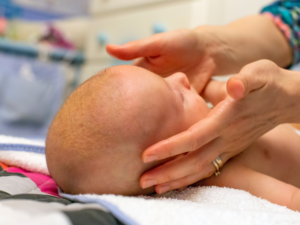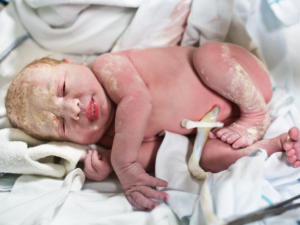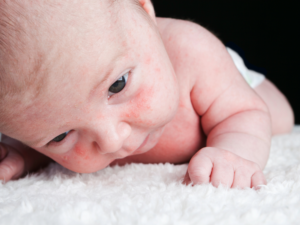Common Skin Conditions (Infants)
Common skin conditions
Newborn babies may have any number of common skin conditions or birthmarks, which may take you a bit off guard at first.
Below is a description of the most common skin conditions that newborn babies have:
Cradle Cap

Cradle cap is peeling skin on your newborn baby’s head. Mild cradle cap should respond to a massage with mineral oil or petroleum jelly to loosen up the peeling scales. You can wash off the scales with baby shampoo. If the peeling is heavy, your doctor may recommend the use of a special shampoo or ointment.
With treatment, cradle cap usually clears up within a few weeks; without treatment, it lasts for months.
Vernix

Vernix is a harmless, thick, white, cheesy film that coats and protects your baby’s skin in the uterus. Some babies are born with more vernix than others. Your health care provider will wipe or wash off your baby’s vernix right after birth and during his first bath. Some vernix might be left on your baby’s skin after his first bath. This is normal. It won’t harm your baby, so there’s no need to scrub it off. The vernix will absorb into your baby’s skin within the first few days. As the vernix is absorbed, the infant’s skin might be dry and flaky or might start to peel as they adjust to the loss of the coating of vernix.
Lanugo
Lanugo is a fine, downy hair that covers your baby’s face, shoulders and back. It develops on your baby in the uterus and will rub off and disappear within a week or two.
- For a photo of lanugo, visit the Stanford School of Medicine website.
Acrocyanosis
Some newborns have acrocyanosis right after they’re born: the head, shoulders and chest are pink, but the hands and feet look blue or purple. This discolouring is normal and will fix itself as your baby’s blood flow increases.
- For a photo of acrocyanosis, visit the Stanford School of Medicine website
Erythema toxicum
These are yellow-white bumps surrounded by red splotches. These lesions may be anywhere on the skin except the palms of the hands and the soles of the feet. They should disappear within the first week or two. This is one of the most common rashes seen on a newborn baby.
- For a photo of erythema toxicum, visit the Stanford School of Medicine website.
Milia

These are small, pearly, white spots on the newborn baby’s forehead, cheeks, and nose. They look like whiteheads, and although they appear to be raised bumps, they are actually smooth. Milia form when a skin lubricant called sebum builds up within the newborn baby’s skin. Within the first couple of weeks of life, the baby’s oil glands and pores will become more mature, and the milia will disappear. It is best to leave these spots alone and let them disappear naturally.
- For more photos of milia, visit the Stanford School of Medicine website.
Newborn acne
These are red spots with yellow centres, also called neonatal urticaria, which occur when the pores in the newborn baby’s skin do not yet work efficiently. Although they may look like an infection, they are not, and they do not need any treatment. Neonatal urticaria will go away on its own.
- For a photo of newborn acne, see Web MD – Acne Health Centre.
Services related to this information:
- Contact your Public Health Nurse
- 811 HealthLine (Newfoundland & Labrador) – Call 811 or 1-888-709-2929 / TTY 1-888-709-3555
